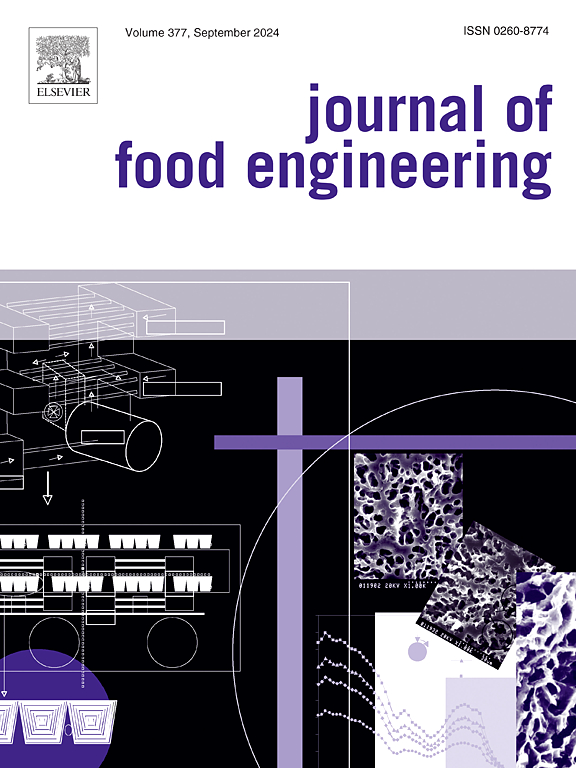Exploiting xanthan–guar gum interactions for stable avocado oil emulsions: A multi-stage kinetic and rheological approach
IF 5.8
2区 农林科学
Q1 ENGINEERING, CHEMICAL
引用次数: 0
Abstract
Avocado oil offers a valuable source of monounsaturated fatty acids and bioactive compounds, but stabilizing it in food emulsions requires effective thickening and droplet protection. This study explores how xanthan gum (XG) and guar gum (GG), individually and in blends of varying ratios (GG:XG = 1.0:0.0 to 0.0:1.0), impact the stability, texture, and droplet-size evolution of avocado oil emulsions at three oil contents (1 %, 5 %, 10 %) and storage temperatures (5 °C, 25 °C, 45 °C). Emulsion stability was assessed via spectrophotometric turbidity measurements and kinetic modeling to capture the flocculation (kf) and coalescence (kd) phases, while texture profile analysis revealed time-dependent changes in firmness, cohesiveness, and work of cohesion. Droplet-size distributions were measured by microscopy and analyzed under a log-normal model. Results show that xanthan-enriched (≥0.75 XG) emulsions exhibit slower flocculation onset owing to higher zero-shear viscosity, yet eventually become susceptible to coalescence at elevated temperatures (45 °C) and higher oil fractions (≥5 %). Guar-rich systems initially display rapid droplet flocculation (high kf), forming transient floc structures that undermine long-term stability. An intermediate ratio (0.5:0.5) balances the flexible thickening of guar with xanthan's more robust network, yielding minimized coalescence rates and stable droplet sizes. A depletion-potential model, incorporating polymer layer thickness and osmotic pressure, confirmed that guar-rich blends experience deep negative potentials (≥103 kB T), indicative of strong depletion flocculation. Taken together, these findings elucidate that formulating avocado oil emulsions demands precise tuning of XG:GG ratios to avoid excessive depletion flocculation while promoting cost-effective, texture-enhancing synergy.
利用黄原胶与瓜尔胶的相互作用制备稳定的牛油果油乳剂:多阶段动力学和流变学方法
鳄梨油提供了单不饱和脂肪酸和生物活性化合物的宝贵来源,但在食品乳剂中稳定它需要有效的增稠和液滴保护。本研究探讨了黄原胶(XG)和瓜尔胶(GG)在三种含油量(1%、5%、10%)和储存温度(5°C、25°C、45°C)下分别和以不同比例(GG:XG = 1.0:0.0至0.0:1.0)混合时对牛油果油乳剂的稳定性、质地和液滴大小演变的影响。通过分光光度浊度测量和动力学建模来评估乳液的稳定性,以捕获絮凝(kf)和聚结(kd)相,而结构剖面分析揭示了牢固性、内聚性和内聚功的随时间变化。用显微镜测量液滴大小分布,并在对数正态模型下进行分析。结果表明,黄原胶富集乳状液(≥0.75 XG)由于具有较高的零剪切粘度,絮凝开始较慢,但在高温(45°C)和高油分(≥5%)条件下,最终易发生聚结。富瓜尔体系最初表现出快速的液滴絮凝(高kf),形成瞬态絮凝结构,破坏长期稳定性。中间比例(0.5:0.5)平衡了瓜尔胶的柔韧增稠与黄原胶更坚固的网络,产生最小的结结率和稳定的液滴大小。考虑聚合物层厚度和渗透压的耗尽电位模型证实,富含瓜尔胶的共混物具有深负电位(≥103 kB T),表明存在强耗尽絮凝作用。综上所述,这些研究结果表明,配制鳄梨油乳剂需要精确调整XG:GG的比例,以避免过度耗散絮凝,同时促进成本效益,增强质地的协同作用。
本文章由计算机程序翻译,如有差异,请以英文原文为准。
求助全文
约1分钟内获得全文
求助全文
来源期刊

Journal of Food Engineering
工程技术-工程:化工
CiteScore
11.80
自引率
5.50%
发文量
275
审稿时长
24 days
期刊介绍:
The journal publishes original research and review papers on any subject at the interface between food and engineering, particularly those of relevance to industry, including:
Engineering properties of foods, food physics and physical chemistry; processing, measurement, control, packaging, storage and distribution; engineering aspects of the design and production of novel foods and of food service and catering; design and operation of food processes, plant and equipment; economics of food engineering, including the economics of alternative processes.
Accounts of food engineering achievements are of particular value.
 求助内容:
求助内容: 应助结果提醒方式:
应助结果提醒方式:


